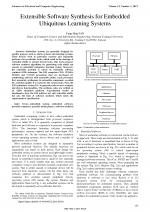| 3/2015 - 19 |
Extensible Software Synthesis for Embedded Ubiquitous Learning SystemsFAN, Y.-H. |
| Extra paper information in |
| Click to see author's profile in |
| Download PDF |
Author keywords
embedded system, embedded software, portable computers, portable media players, software synthesis
References keywords
embedded(13), systems(12), software(12), middleware(9), distributed(7), oriented(6), design(6), time(5), system(5), real(5)
Blue keywords are present in both the references section and the paper title.
About this article
Date of Publication: 2015-08-31
Volume 15, Issue 3, Year 2015, On page(s): 133 - 140
ISSN: 1582-7445, e-ISSN: 1844-7600
Digital Object Identifier: 10.4316/AECE.2015.03019
Web of Science Accession Number: 000360171500019
SCOPUS ID: 84940762307
Abstract
Embedded systems are generally designed for specific purpose such as alarm systems and learning systems. These devices work in particular scenario and repeatedly perform a few particular tasks, which result in the shortage of extensible ability to execute diverse tasks. This work proposes software synthesis algorithms for generating code which can execute on embedded ubiquitous learning system. Moreover, the extensible problem is solved by extensible software synthesis (E2S) technique. The E2S comprises CEO, CEOAS, CBOAS and CTOAS procedures that are developed for synthesizing software with extensible ability. Each procedure first separately synthesizes its extensible component, so-called EC, and then applies it to construct the various tasks. Next, the E2S synthesizes various ECs to generate codes to serve complex and diverse functionalities. The synthesis codes are verified on an ARM emulation platform. Experimental results on benchmarks show the E2S achieves not only extensible ability but also the time of software synthesis which meets the requirement of specification. |
| References | | | Cited By |
Web of Science® Times Cited: 1 [View]
View record in Web of Science® [View]
View Related Records® [View]
Updated today
SCOPUS® Times Cited: 1
View record in SCOPUS® [Free preview]
View citations in SCOPUS® [Free preview]
[1] Multiple-Embedded-System Optimization Layout for Electromagnetic Wave Power Density in Complex Environments, Fan, Yang-Hsin, Energies, ISSN 1996-1073, Issue 18, Volume 13, 2020.
Digital Object Identifier: 10.3390/en13184758 [CrossRef]
Disclaimer: All information displayed above was retrieved by using remote connections to respective databases. For the best user experience, we update all data by using background processes, and use caches in order to reduce the load on the servers we retrieve the information from. As we have no control on the availability of the database servers and sometimes the Internet connectivity may be affected, we do not guarantee the information is correct or complete. For the most accurate data, please always consult the database sites directly. Some external links require authentication or an institutional subscription.
Web of Science® is a registered trademark of Clarivate Analytics, Scopus® is a registered trademark of Elsevier B.V., other product names, company names, brand names, trademarks and logos are the property of their respective owners.
Faculty of Electrical Engineering and Computer Science
Stefan cel Mare University of Suceava, Romania
All rights reserved: Advances in Electrical and Computer Engineering is a registered trademark of the Stefan cel Mare University of Suceava. No part of this publication may be reproduced, stored in a retrieval system, photocopied, recorded or archived, without the written permission from the Editor. When authors submit their papers for publication, they agree that the copyright for their article be transferred to the Faculty of Electrical Engineering and Computer Science, Stefan cel Mare University of Suceava, Romania, if and only if the articles are accepted for publication. The copyright covers the exclusive rights to reproduce and distribute the article, including reprints and translations.
Permission for other use: The copyright owner's consent does not extend to copying for general distribution, for promotion, for creating new works, or for resale. Specific written permission must be obtained from the Editor for such copying. Direct linking to files hosted on this website is strictly prohibited.
Disclaimer: Whilst every effort is made by the publishers and editorial board to see that no inaccurate or misleading data, opinions or statements appear in this journal, they wish to make it clear that all information and opinions formulated in the articles, as well as linguistic accuracy, are the sole responsibility of the author.





